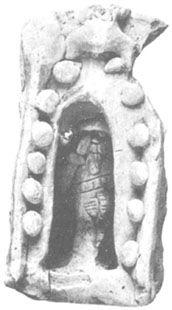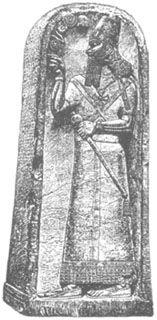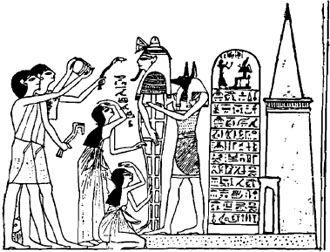The 12th Planet (23 page)
Authors: Zecharia Sitchin
Tags: #Non-Fiction, #Gnostic Dementia, #Fringe Science, #Retail, #Archaeology, #Ancient Aliens, #History


Fig. 71

Fig. 72
That the purpose of the commemorative stone pillars was to simulate a
fiery
skyship can further be gleaned from the term by which such stone stelae were known in antiquity. The Sumerians called them NA.RU ("stones that rise"). The Akkadians, Babylonians, and Assyrians called them
naru
("objects that give off light"). The Amurru called them
nuras
("fiery objects"—in Hebrew,
ner
still means a pillar that emits light, and thus today's "candle"). In the Indo-European tongues of the
H
urrians and the Hittites, the stelae were called
h
u-u-ashi
("fire bird of stone").
Biblical references indicate familiarity with two types of commemorative monument, a
yad
and a
shem.
The prophet Isaiah conveyed to the suffering people of Judaea the Lord's promise of a better and safer future:
And I will give them,
In my House and within my walls,
A
yad
and a
shem.
Literally translated, this would amount to the Lord's promise to provide his people with a "hand" and a "name." Fortunately, however, from ancient monuments called
yad's
that still stand in the Holy Land, we learn that they were distinguished by tops shaped like pyramidions. The
shem,
on the other hand, was a memorial with an
oval
top. Both, it seems evident, began as simulations of the "sky chamber," the gods' vehicle for ascending to the Eternal Abode. In ancient Egypt, in fact, the devout made pilgrimages to a special temple at Heliopolis to view and worship the
ben-ben--a
pyramidion-shaped object in which the gods had arrived on Earth in times immemorial. Egyptian pharaohs, on their deaths, were subjected to a ceremony of "opening of the mouth," in which they were supposed to be transported by a similiar
yad
or a
shem
to the divine Abode of Eternal Life. (Fig. 73)
The persistence of biblical translators to employ "name" wherever they encounter
shem
has ignored a farsighted study published more than a century ago by G. M. Redslob (in
Zeitschrift der Deutschen Morgenlandischen Gesellschaft)
in which he correctly pointed out that the term
shem
and the term
shamaim
("heaven") stem from the root word
shamah,
meaning "that which is highward." When the Old Testament reports that King David "made a
shem"
to mark his victory over the Aramaeans, Redslob said, he did not "make a name" but set up a monument pointing skyward.
The realization that
mu
or
shem
in many Mesopotamian texts should be read not as "name"' but as "sky vehicle" opens the way to the understanding of the true meaning of many ancient tales, including the biblical story of the Tower of Babel.

Fig. 73
The Book of Genesis, in its eleventh chapter, reports on the attempt by humans to raise up a
shem.
The biblical account is given in concise (and precise) language that bespeaks historical fact. Yet generations of scholars and translators have sought to impart to the tale only an allegorical meaning because—as they understood it—it was a tale concerning Mankind's desire to "make a
name"
for itself. Such an approach voided the tale of its factual meaning; our conclusion regarding the true meaning of
shem
makes the tale as meaningful as it must have been to the people of antiquity themselves.
The biblical tale of the Tower of Babel deals with events that followed the repopulation of Earth after the Deluge, when some of the people "journeyed from the east, and they found a plain in the land of Shin'ar, and they settled there."
The Land of Shinar is, of course, the Land of Sumer, in the plain between the two rivers in southern Mesopotamia. And the people, already knowledgeable concerning the art of brickmaking and high-rise construction for an urban civilization, said:
"Let us build us a city,
and a tower whose top shall reach the heavens;
and let us make us a
shem,
lest we be scattered upon the face of the Earth."
But this human scheme was not to God's liking.
And the Lord came down,
to see the city and the tower
which the Children of Adam had erected.
And he said: "Behold,
all are as one people with one language,
and this is just the beginning of their undertakings;
Now, anything which they shall scheme to do
shall no longer be impossible for them."
And the Lord said—to some colleagues whom the Old Testament does not name:
"Come, let us go down,
and there confound their language;
So that they may not understand each other's speech."
And the Lord scattered them from there
upon the face of the whole Earth,
and they ceased to build the city.
Therefore was its name called Babel,
for there did the Lord mingle the Earth's tongue.
The traditional translation of
shem
as "name" has kept the tale unintelligible for generations. Why did the ancient residents of Babel—Babylonia—exert themselves to "make a name," why was the "name" to be placed upon "a tower whose top shall reach the heavens," and how could the "making of a name" counteract the effects of Mankind's scattering upon Earth?
If all that those people wanted was to make (as scholars explain) a "reputation" for themselves, why did this attempt upset the Lord so much? Why was the raising of a "name" deemed by the Deity to be a feat after which "anything which they shall scheme to do shall no longer be impossible for them"? The traditional explanations certainly are insufficient to clarify why the Lord found it necessary to call upon other unnamed deities to go down and put an end to this human attempt.
We believe that the answers to all these questions become plausible—even obvious—once we read "skyborne vehicle" rather than "name" for the word
shem,
which is the term employed in the original Hebrew text of the Bible. The story would then deal with the concern of Mankind that, as the people spread upon Earth, they would lose contact with one another. So they decided to build a "skyborne vehicle" and to erect a
launch tower
for such a vehicle so that they, too, could—like the goddess Ishtar, for example—fly in a
mu
"over all the peopled lands."
A portion of the Babylonian text known as the "Epic of Creation" relates that the first "Gateway of the Gods" was constructed in Babylon by the gods themselves. The Anunnaki, the rank-and-file gods, were ordered to
Construct the Gateway of the Gods....
Let its brickwork be fashioned.
Its
shem
shall be in the designated place.
For two years, the Anunnaki toiled—"applied the implement ... molded bricks"—until "they raised high the top of Eshagila" ("house of Great Gods") and "built the stage tower as high as High Heaven."
It was thus some cheek on the part of Mankind to establish its own launch tower on a site originally used for the purpose by the gods, for the name of the place—Babili—literally meant "Gateway of the Gods."
Is there any other evidence to corroborate the biblical tale and our interpretation of it?
The Babylonian historian-priest Berossus, who in the third century
B.C.
compiled a history of Mankind, reported that the "first inhabitants of the land, glorying in their own strength ... undertook to raise a tower whose 'top' should reach the sky." But the tower was overturned by the gods and heavy winds, "and the gods introduced a diversity of tongues among men, who till that time had all spoken the same language."
George Smith
(The Chaldean Account of Genesis)
found in the writings of the Greek historian Hestaeus a report that, in accordance with "olden traditions," the people who had escaped the Deluge came to Senaar in Babylonia but were driven away from there by a diversity of tongues. The historian Alexander Polyhistor (first century
B.C.
) wrote that all men formerly spoke the same language. Then some undertook to erect a large and lofty tower so that they might "climb up to heaven." But the chief god confounded their design by sending a whirlwind; each tribe was given a different language. "The city where it happened was Babylon."
There is little doubt by now that the biblical tales, as well as the reports of the Greek historians of 2,000 years ago and of their predecessor Berossus, all stem from earlier—Sumerian—origins. A. H. Sayee
(The Religion of the Babylonians)
reported reading on a fragmentary tablet in the British Museum "the Babylonian version of the building of the Tower of Babel." In all instances, the attempt to reach the heavens and the ensuing confusion of tongues are basic elements of the version. There are other Sumerian texts that record the deliberate confusion of Man's tongue by an irate god.
Mankind, presumably, did not possess at that time the technology required for such an aerospace project; the guidance and collaboration of a knowledgeable god was essential. Did such a god defy the others to help Mankind? A Sumerian seal depicts a confrontation between armed gods, apparently over the disputed construction by men of a stage tower. (Fig. 74)
